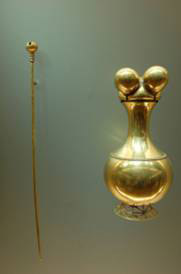Узор Кимбая

The Quimbaya civilization is a South American civilization, noted for its spectacular goldwork characterized by its technical accuracy and detailed designs. The majority of the goldwork is made in tumbaga alloy, with 30% copper, which gives to the pieces beautiful color tonalities. They inhabited the areas corresponding the modern departments of Quindío, Caldas and Risaralda in Colombia, around the valley of the Cauca river. There is no clear data about when they were initially established but it is currently set round the first century B.C.
The quimbaya people reached their apogee of development during the 4th to 7th century A.C., period known as the Quimbaya Classic. From this period is the most emblematic piece of this culture: the Poporo Quimbaya (currently exhibited in the Gold Museum. The most frecuent designs in the artpieces are anthropomorphic, depicting men and women sitting, with closed eyes and placid expression. There is also many designs of fruits and poporos.
Most of the retrieved items are part of funeral offers, found in the inside of sarcophagus made of hollow trunks. The gold represented a sacred metal and the passport for the afterlife. Around the 10th century A.C. the Quimbaya culture disappeared entirely due to unknown circumstances; the studies of the archeological items points to an advanced cultural development and the political structure of a cacicazgo with separated groups dedicated to pottery, religion, trade, goldwork and war.
The quimbaya people reached their apogee of development during the 4th to 7th century A.C., period known as the Quimbaya Classic. From this period is the most emblematic piece of this culture: the Poporo Quimbaya (currently exhibited in the Gold Museum. The most frecuent designs in the artpieces are anthropomorphic, depicting men and women sitting, with closed eyes and placid expression. There is also many designs of fruits and poporos.
Most of the retrieved items are part of funeral offers, found in the inside of sarcophagus made of hollow trunks. The gold represented a sacred metal and the passport for the afterlife. Around the 10th century A.C. the Quimbaya culture disappeared entirely due to unknown circumstances; the studies of the archeological items points to an advanced cultural development and the political structure of a cacicazgo with separated groups dedicated to pottery, religion, trade, goldwork and war.